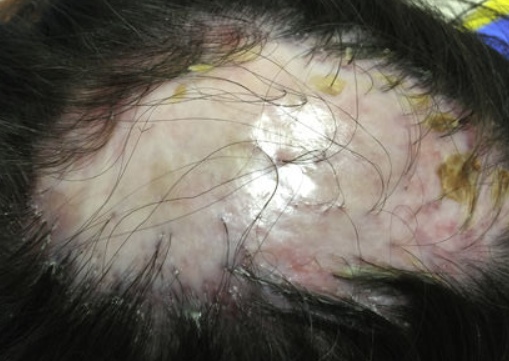Folliculitis decalvans is a group of disorders affecting the hair-bearing portion of the scalp, characterized by painful acute inflammatory changes with or without pustules. Recurrent episodes of inflammation result in scarring alopecia and destructive folliculitis. ICD-10 Code: L66.2.
It is usually found in adult males but can also occur in adolescents, children, and even infants. Although Staphylococcus aureus is often detected in the material from the pustules, folliculitis decalvans is not an infectious disease but may represent an abnormal response of the body to staphylococcal antigens or toxins.The inflammatory manifestations are clinically less pronounced than in other forms of bacterial infection. The disease is characterized by a long, indolent course with periodic exacerbations.
The patches of scarring alopecia vary in size and shape and are numerous. In some cases, they coalesce to form larger patches (2-3 cm in diameter) with distinct irregular borders. The localization is on the hair-bearing part of the scalp (mainly in the temporal and vertex regions along the hairline) and, in rare cases, in the axillary, beard and pubic regions.
Although the inflammatory patches on the scalp usually resolve with treatment, this condition has a chronic course with frequent recurrences.
Diagnosis is based on the characteristic clinical presentation, histological findings and trichosopy.
Pathohistological studies reveal the presence of acute folliculitis with a perifollicular infiltrate.- Scalp folliculitis
- Tinea capitis
- Lichen planopilaris
- Acne keloidalis nuchae
- Discoid lupus erythematosus
- Folliculitis et perifolliculitis capitis abscedens et suffodiens
- Bacterial folliculitis
Systemic Treatment:
The treatment of choice is systemic antibiotics.
The following drugs are commonly used:
- Erythromycin 1 g/day
- Clarithromycin 500 mg/day
- Cephalosporins or tetracyclines (minocycline 100 mg/day or doxycycline 200 mg/day)
- These medications are generally effective in stopping the inflammatory process, but recurrences are common after treatment is discontinued. Combination therapy with fusidic acid 1500 mg/day for 3 weeks and zinc sulfate 400 mg/day resulted in sustained remission in 3 patients.
- A combination of rifampicin 300 mg and clindamycin 300 mg orally twice daily for 10 weeks is probably the most effective treatment. This is because rifampicin has immunomodulatory effects in addition to its anti-staphylococcal activity. This regimen results in prolonged remission in most patients. Combined therapy is necessary to avoid resistance to rifampicin, which often develops when this antibiotic is used as monotherapy.
- Isotretinoin at a dose of 0.5-1 mg/kg per day significantly improves scalp inflammation in most cases. A short course of systemic and topical steroids is prescribed to suppress inflammation in combination with systemic antibiotics.
Topical treatment:
Shampoos containing antibacterial agents or 2% ketoconazole may help prevent recurrences. Shaving the head may improve the condition.

